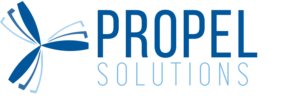After a few months working from home, employees have started to feel the strain of ineffective technology and are experiencing frustration with processes that were never designed to be executed remotely. This is not surprising, organizations around the world had to make snap decisions to move to a remote workplace in mid-March. Overnight, employees were expected to execute their work from home, without any training on the use of remote technology, or established processes to maintain collaboration and connectivity.
With many companies keeping their office staff at home for the foreseeable future, it is time for leaders to look at implementing permanent work from home solutions. (For organizations that have returned to work, check our article on how Lean Improvement can help organizations thrive in a post Covid World.)
To ensure that workers are successful, organizations will need to streamline processes and adopt effective collaboration tools such as Microsoft 365. Companies are now more vulnerable than ever and the ones who get this right will thrive in the “new normal”. There are three pillars required for creating effective virtual workplaces: productivity, connectivity, and security. Below are the key considerations for organizations to move forward:
Productivity
To be effective, remote work processes need to be designed with clear roles and accountabilities as well as defined expectations. Employees are having to work staggered hours to accommodate additional commitments at home and autonomy with work processes will allow for more flexibility in the hours that are required. One sure fire sign that your processes are not effectively designed is marathon meetings with multiple levels of the organization and/or email chains with multiple departments copied. Effective process design will allow for autonomy of the employees to progress their work independently with a clear line of accountability for when and who will sign off on the process. There is no need to sit on Zoom calls all day to develop the process, it is already understood by the team and the progress of the work can be measured with variances understood by stakeholders. To mitigate concerns of productivity, we have seen examples of employees booked in back-to-back meetings so that managers can be assured their teams are working. This, however, leaves little time for employees to get any real work done. The attempt to supervise and connect employees has instead created frustration, resulting in a skewed work-life balance.
Process inefficiencies and lack of accountability in organizations are now magnified as it is more challenging to move processes along now that you can’t just drop by someone’s desk and employees are having to work alternate work hours to accommodate their home commitments like home school. Additionally, it is far more difficult to understand the status of a project when there is no visibility or informal run ins. Microsoft, although a leader in online collaboration tools, was slow to market their offering. Many organizations did not realize that they had powerful tools already purchased through Teams, SharePoint, Exchange and Document Collaboration tools that could be leveraged to radically improve the productivity of their remote teams.
Connectivity
Many employees left the workplace with only the technology available on their desk, were not aware of the powerful tools they already had access to with Microsoft. This resulted in many employees leveraging tools that they are familiar with from their personal lives, such as Zoom and Google, which were not intended for use in the Canadian workplace. In addition to dealing with the stress caused by pandemic, employees were left to learn how to connect to their workplaces remotely. With fractured use of technology, processes have been broken and a deepening of silo’s in the workplace is taking place as each team has selected the tools that they are the most comfortable with to maintain their processes. To compound these effects organizations are paying for several licenses for these new work from home platforms rather than leveraging tools that they are already paying for like Microsoft 365 and Teams.
Security
Many organizations did not realize that they already were paying for Microsoft 365’s best in class security that was compliant with Canadian Personal Information and Electronics Document Act (PIPEDA) that is included in their monthly subscription. Microsoft, although a leader in online collaboration tools, was slow to react to the new environment and perhaps wrongly believed that organizations understood how to leverage their full suite of tools to make the move to work from home.
Zoom and Google Drive, despite recent popularity, contain many security flaws and are non-compliant with PIPEDA which requires that personal information of Canadians (including names, phone numbers and addresses etc.) remains in Canada. Organizations are shelling out additional money in knee jerk reactions to bridge the gaps in their technology stack as organizations scramble to keep up with the changing regulations requirements while keeping the lights on.
Moving Forward
With remote work here to stay for the foreseeable future, it is time to start looking at how to transform your organization into a truly digitally enabled workplace. Through our partnership with Microsoft we are able to offer 6 months free subscription to Microsoft 365 and provide organizations with the tools necessary to develop effective digital processes. Taking the time to get this right will not only increase productivity, but maintain employees’ connection to the workplace while maximizing information security.
Below are the steps needed to enable a productive, connective, and secure workplace enabling a successful virtual workplace:
- Process Definition and Digitization: Cumbersome processes with many handoffs will need to be streamlined to allow the processes to progress without many layers of approval or handoffs.
- Document Management & Use of Tools: Processes need to be designed to leverage tools and outline clear accountabilities for decisions. This will limit the number of touch points required to get the job done.
- Collaboration and Productivity: Meetings should have a clearly outlined agenda with a defined objective to maximize employees’ time. The cost of technology will need to be considered to ensure it makes sense for your organization’s budget as government grants are used up.
- Visual Work Place and Dashboards: Digital dashboards will need to be developed to ensure the organization is still achieving its key objectives despite the workforce working remotely.
Wherever you are on your digital transformation, Propel is here to help your organization shift gears. We offer technology assessments that will help identify opportunities for businesses to fully adopt a digital workplace that works. We will ensure that there is a demonstrated return on your investment and identify how your team can be more productive, secure, and compliant to achieve effective and productive.
At Propel we are committed to ensuring that companies thrive in these new economic realities. Please let us know your thoughts on the future of the work environment and what impacts you will see in your industry. Our mission is to facilitate an open exchange of ideas that organizations can apply to weather the storm. Additionally, we are always available for a conversation to discuss your workplace’s specific concerns. You can contact us directly at 604.346.5185 or [email protected] . Let our team of Microsoft experts lend a hand.
Propel Solutions
- 📍 789 W. Pender Street, Vancouver, BC, Canada
- 📞 604-346-5185








